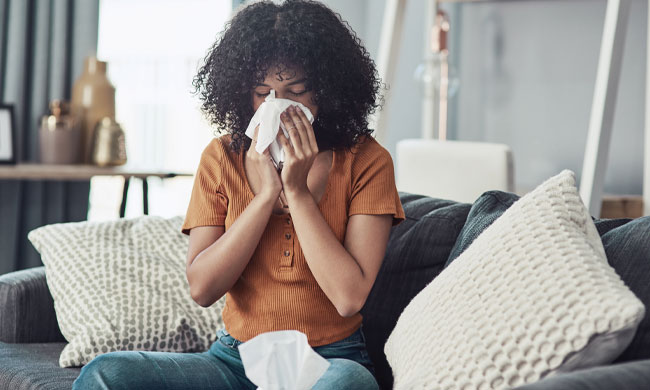HEALTHY LIVING
Go beyond quick fixes with long-term allergy relief options

4 tips to tackle and alleviate symptoms for lasting relief
(Family Features) Warmer weather means flowers and trees are blooming, but for the millions of Americans who suffer from seasonal allergies, it also means coughing, sneezing, itchy eyes, congestion and other symptoms aren’t far behind.
Allergies, defined by the Asthma and Allergy Foundation of America (AAFA) as an immune reaction to a foreign substance, or allergen, can develop after an allergen is ingested, inhaled, injected or touched. About one-quarter (25.7%) of adults suffer from seasonal allergies, according to the Centers for Disease Control and Prevention, which are commonly caused by grass, tree and weed pollens.
When allergies act up, many people reach for medications like antihistamines, decongestants and other over-the-counter (OTC) medicines for quick, yet temporary, symptom relief. While symptoms may subside, there are side effects to prolonged use of OTC medicines such as dry mouth, drowsiness and blurred vision, among others.
Innovative alternatives, such as allergy immunotherapy, are now available from the convenience of a patient’s home. This treatment offers more effective long-term relief compared to antihistamine pills, which only mask symptoms temporarily. Sublingual immunotherapy is an effective option for people who don’t want the inconvenience or safety risk associated with allergy shots.
“More than 120 million people in the U.S. suffer from allergies and their related diseases, making it the most prevalent chronic illness facing our nation,” said Dr. Ken Chahine, Ph.D., J.D., founding CEO of Nectar Life Sciences. “Nectar’s mission is to empower consumers with breakthrough solutions that can put an end to allergies and, in turn, build healthier, more productive communities.”
To help combat symptoms this allergy season, which will be longer and more intense due to climate change, according to the AAFA, consider these tips for long-lasting symptom relief.
Recognize Allergy Symptoms
Although seasonal allergies typically affect the nose, eyes, mouth and sinuses, the symptoms and triggers can vary among individuals. While itching in the roof of the mouth, hives and watery eyes are considered classic allergy symptoms, others may resemble signs of illness or infection, such as coughing, sneezing, congestion, body aches, pain or a stuffy or runny nose. If these symptoms persist for a week or two, it is possible you are reacting to seasonal allergens. Conversely, if you experience symptoms throughout the year, they might be caused by common allergens found in homes and workplaces, such as dust, mold or pet dander.
Reduce Exposure to Allergens Outdoors The best way to avoid allergy symptoms is by eliminating or reducing exposure to triggers. In the case of seasonal allergies, the primary trigger is typically pollen. This may require staying indoors on dry and windy days or choosing to go outside later in the day when pollen counts are generally lower. Before heading outside, check pollen forecasts and current levels in the area.
The best way to avoid allergy symptoms is by eliminating or reducing exposure to triggers. In the case of seasonal allergies, the primary trigger is typically pollen. This may require staying indoors on dry and windy days or choosing to go outside later in the day when pollen counts are generally lower. Before heading outside, check pollen forecasts and current levels in the area.
Rainfall helps clear pollen from the air, making rainy or cloudy days ideal for outdoor activities. However, many outdoor activities rely on clear and sunny weather. In such situations, taking additional precautions becomes necessary. For instance, try wearing a face mask while performing outdoor chores like mowing, gardening or pulling weeds, which can stir up allergens. It’s also important to refrain from hanging laundry outside, as pollen tends to adhere to linens and clothing. People should promptly remove clothes after being outside and take a bath to rinse off any pollen from the skin and hair. Bringing allergens indoors, especially onto bedding, can worsen symptoms or prolong their duration. Additionally, closing doors and windows when pollen counts are high is advisable.
Look for Long-Term Symptom Relief
While allergen avoidance and OTC medications like antihistamines and decongestants can be effective, they may not work for everyone. For those seeking an alternative to antihistamines, allergy immunotherapy offers a viable option. With more than 100 years of clinical practice, allergy immunotherapy has shown it can improve long-term quality of life. The concept behind this therapy is to regularly expose the body to the allergen, gradually building immunity and reducing sensitivity, ultimately leading to fewer or even no allergy symptoms.
Sublingual immunotherapy is an innovative form of immunotherapy that is common in Europe and is now available in the U.S. It involves taking two drops per day of a personalized prescription under the tongue to achieve the same long-term relief that allergy shots can provide. Allergy care platform Nectar offers a comprehensive allergy treatment program that can be conducted from the comfort of a patient’s home. The program begins with an at-home allergy test, which is Clinical Laboratory Improvement Amendments-certified and covers a wide range of indoor and outdoor allergens. After carefully reviewing the test results and taking into account the patient’s clinical history and geographic location, a licensed provider determines the most suitable treatment option. The personalized prescription is then delivered to the patient every three months. Over time, as the body builds tolerance to the allergens, symptoms generally diminish and fade away.
“Sublingual immunotherapy allergy drops have been used and studied extensively in Europe for more than 30 years but have only recently started to gain popularity in the U.S.,” said Dr. Shyam Joshi, MD, board certified allergist and immunologist and chief medical officer at Nectar Life Sciences. “Our allergy drops are unique from most others in the U.S. market because the allergen concentrations we use are higher than other allergy drops, which, based on scores of clinical studies conducted both in Europe and the U.S., are necessary to achieve clinical benefits and long-term relief.”
Keep Indoor Air Clean
To maintain allergen-free indoor spaces, it is advisable to refrain from opening windows in the house or car when pollen counts are high. However, there are other measures you can take to minimize exposure indoors. Utilizing an air conditioner equipped with high-efficiency filters and adhering to regular maintenance schedules for heating and cooling systems are effective strategies. Additionally, frequent dusting of countertops, shelves and tables is recommended, along with cleaning carpets using a vacuum cleaner equipped with a high-efficiency particulate air (HEPA) filter. Using a dehumidifier can help maintain dry indoor air and reduce the risk of mold growth. Furthermore, consider installing portable air purifiers with built-in HEPA filters in bedrooms or frequently occupied rooms throughout the home.
To learn more or access online resources that can help you fight allergies, such as the Help Center and Learning Hub, visit MyNectar.com.
Photos courtesy of Getty Images
SOURCE:
Nectar
HEALTHY LIVING
Save a life from stroke

(Family Features) Strokes can happen to anyone, at any age – even young people. Despite being one of the leading causes of death and long-term disability in the United States, strokes are largely preventable, treatable and beatable – if you can control your risk factors.
According to the American Stroke Association, a division of the American Heart Association, every 40 seconds, someone in the U.S. has a stroke. Keeping blood pressure in check, living a healthy lifestyle and knowing stroke warning signs may help protect you and your loved ones.
Here are key insights from the American Stroke Association’s Together to End Stroke initiative, nationally supported by the HCA Healthcare Foundation.
Controlling Risk Factors
Up to 80% of strokes may be preventable, according to the American Stroke Association. You can take action to prevent strokes by managing your risk factors, like high blood pressure, a leading cause and controllable risk factor for stroke and heart disease.
Other risk factors include diabetes and obesity, which can be kept in check with healthy lifestyle behaviors such as good nutrition. Quitting smoking and being physically active are important. Atrial fibrillation, or AFib, which is a quivering or irregular heartbeat, also increases stroke risk. In fact, people with AFib are five times more likely to have a stroke, according to the American Heart Association.
Preventing a Second Stroke
Nearly 1 in 4 strokes occur in people who had a previous stroke, sometimes because they don’t know what caused the first, making identifying the cause of the stroke a key step toward future prevention. Treatment depends on the type of stroke someone is having, which can be determined with a series of medical evaluations and tests.
Work with your health care professional to develop a plan that helps you move forward after a first stroke while preventing a second. This plan should include controlling risk factors, like achieving and maintaining healthy blood pressure, blood sugar and cholesterol levels.
“Preventing a second stroke is possible with the right approach,” said Teresita Casanova, MD, HCA Healthcare affiliated neurologist and American Stroke Association volunteer expert. “Taking medicines as prescribed, monitoring health numbers, and making small, consistent lifestyle changes can make a big difference. Stroke survivors should feel empowered to take control of their health and work with their care team to build a strong prevention plan.”
To help you in your journey, you can rely on tools such as the Heart & Stroke Helper, a free self-management app available for stroke survivors and their caregivers. The app allows patients to oversee their health in one place with features that track progress on lifestyle habits, manage medications, track health numbers, provide information about stroke and allow patients to connect with others for inspiration.
Find more ways to manage second stroke risk at Stroke.org

Act F.A.S.T.: How to Detect Signs of Stroke
Most adults in the U.S. don’t know the stroke warning signs, nor that stroke is largely treatable if you call 911 as soon as you recognize the symptoms.
Learning the acronym F.A.S.T. can help you recognize that someone may be having stroke symptoms so you can take life-saving action.
F: Face Drooping. Does one side of the face droop, or is it numb? Ask the person to smile. Is the person’s smile uneven?
A: Arm Weakness. Is one arm weak or numb? Ask the person to raise both arms. Does one arm drift downward?
S: Speech. Is speech slurred? Is the person unable to speak or hard to understand? Ask the person to repeat a simple sentence, like “The sky is blue.”
T: Time to Call 911. If you or anyone else shows any of these symptoms, call 911 immediately.
Photo courtesy of Shutterstock
SOURCE:
HEALTHY LIVING
How to conduct a skin care self-exam

Time spent soaking up the summer sun is one of the things that makes the season so appealing. Warm outdoor air has a calming effect that can make anyone feel more relaxed and comfortable.
As good as warm summer sun can feel, overexposure to the sun can be dangerous. The World Cancer Research Fund reports there were more than 330,000 new cases of skin cancer diagnosed across the globe in 2022. A significant percentage of skin cancer cases can be prevented, and prevention is a multifaceted process that includes skin care self-examinations. Self-exams do not take up much time, and individuals can speak with their physicians about how frequently they should check their skin for signs of skin cancer. The U.S. National Library of Medicine offers the following instructions for how to conduct a skin self-exam.
Choose the right time to examine your skin. The USNLM recommends conducting a skin exam after bathing. Women who routinely conduct breast self-exams can check their skin at this time as well.
Use a full-length mirror. ItÕs not always easy to examine skin throughout the body. But signs of skin problems can occur anywhere on the body, including areas that might be hard to see without help. If possible, conduct a self-exam of the skin in front of full-length mirror in a brightly lit room.
Identify what youÕre looking for. The USNLM notes you should be looking for any new skin markings. This includes bumps, moles, blemishes, and changes in skin color.
Pay close attention to preexisting moles. A potential sign of skin cancer includes moles that change over time. Examine preexisting moles to see if they have changed in size, texture, color, and shape.
Look for unusual moles. The USNLM characterizes certain moles as Òugly duckling moles.Ó These unique moles look and feel different from nearby moles and may be indicative of skin cancer. Speak with a dermatologist if a self-exam uncovers the presence of moles with uneven edges or differences in colors or asymmetric shapes. Moles that look different from one side to the other also should be brought to the attention of a dermatologist. Moles that do not stop bleeding or will not heal also merit examination by a skin care professional.
When the time comes to conduct the exam, the USNLM recommends following these steps:
- Look closely at your entire body, both front and back, in the mirror.
- Check under your arms and on both sides of each arm. Be sure to examine the backs of your upper arms, which can be hard to see.
- Bend your arms at the elbow, and examine both sides of your forearm.
- Examine the tops and palms of your hands.
- Examine the front and back of both legs.
- Examine your buttocks and between your buttocks.
- Examine your genital area.
- Examine your face, neck, the back of your neck, and scalp. Use both a hand mirror and full-length mirror, along with a comb, to see areas of your scalp.
- Examine your feet, including the soles and the spaces between your toes.
- Ask a person you trust to help examine hard-to-see areas.
Skin cancer poses a formidable threat, but many cases of the disease are preventable. Routine skin self-exams are a vital component of skin cancer prevention. TF256909
HEALTHY LIVING
What does 100% grass-fed organic dairy bring to your table

(Family Features) It’s no secret that many grocery store dairy sections are filled with more options today. One choice continuing to gain favor with consumers is 100% grass-fed organic dairy. Nutrition, environmental awareness and animal care are some of the leading reasons consumers choose grass-fed dairy products.
Globally, the 100% grass-fed dairy market is projected to continue growing and some market experts predict annual growth rates as high as 22%. If you’re curious about 100% grass-fed organic dairy, consider these benefits from Maple Hill, America’s original 100% grass-fed organic dairy producer. The pioneer of 100% grass-fed organic dairy took its commitment a step further by celebrating and declaring National 100% Grass-Fed Organic Dairy Day on April 15, which recognizes the positive impact it has on consumers, cows, farmers and the environment.
1. Honoring the Farmers
Unlike large-scale corporate dairy farms, most organic farms are small, family-owned operations dedicated to traditional, sustainable farming. Small dairy farms have been disappearing, but 100% grass-fed organic dairy creates a sustainable, viable path forward for farmers who work in harmony with nature.
This more natural approach to dairy is a “craft” process favoring small family farmers who are willing to dedicate the extra focus and patience to a better product and process. These family farms are passed on to future generations to grow the “better for you, better for the planet” approach.
2. Commitment to Good Health
Most consumers don’t know the difference between traditional organic and 100% grass-fed organic dairy. One key distinction is the products’ nutritional composition; 100% grass-fed organic dairy provides a 50% healthier ratio of omega 3:6 and 40% higher levels of CLA fatty acids, which may support heart health and provide other health benefits.
What’s more, Maple Hill’s products made with 100% grass-fed organic dairy are GMO free, hormone free and antibiotic free with no additives or fillers. The line of high-quality, rich-flavored products let you experience the organic difference from traditional dairy for a nutrient-dense solution that tastes as nature intended.
3. Happy, Healthy Cows
Cows on a 100% grass-fed diet can live up to three times as long as grain-fed cows and are never subjected to unnatural diets, hormones or antibiotics. More time in pastures filled with lush grass means cows have the freedom to roam, ruminate and graze on diverse, nutrient-rich grasses.
The result is happier, healthier cows, which in turn results in a richer, better-tasting and more nutrient-dense milk.
4. Sustainability and the Environment
Producing milk without grain or corn requires farmers to focus on regenerating soil and the soil life that supports everything else on the farm. In fact, the healthier the soil, the healthier the feed, so farmers have a natural incentive to be as regenerative as possible. Regenerative grazing practices are a powerful and positive tool to improve land and the web of life on farms by actively restoring soil health, promoting biodiversity and reducing the environmental impact compared to conventional dairy.
Well-managed grazing helps pull carbon from the atmosphere into the soil, fighting climate change in the process. In addition, healthier soil retains more water, reducing runoff and protecting water sources from agricultural pollution.
5. Strengthening the 100% Grass-Fed Organic Market
Consumers are increasingly aware of the choices they have in dairy products and how 100% grass-fed organic supports their health, farmers, animals and the planet. Some ways to support this category’s continued growth include choosing certified 100% grass-fed organic dairy, advocating for regenerative farming and helping shape a more sustainable food system.
Learn more about 100% grass-fed organic dairy products at maplehill.com.
SOURCE:
-

 NEWS3 years ago
NEWS3 years ago2 hurt, 1 jailed after shooting incident north of Nocona
-

 NEWS2 years ago
NEWS2 years agoSuspect indicted, jailed in Tia Hutson murder
-

 NEWS2 years ago
NEWS2 years agoSO investigating possible murder/suicide
-

 NEWS2 years ago
NEWS2 years agoWreck takes the life of BHS teen, 16
-

 NEWS2 years ago
NEWS2 years agoMurder unsolved – 1 year later Tia Hutson’s family angry, frustrated with no arrest
-

 NEWS2 years ago
NEWS2 years agoSheriff’s office called out to infant’s death
-

 NEWS2 years ago
NEWS2 years agoBowie Police face three-hour standoff after possible domestic fight
-

 NEWS3 years ago
NEWS3 years agoDriver stopped by a man running into the street, robbed at knifepoint






